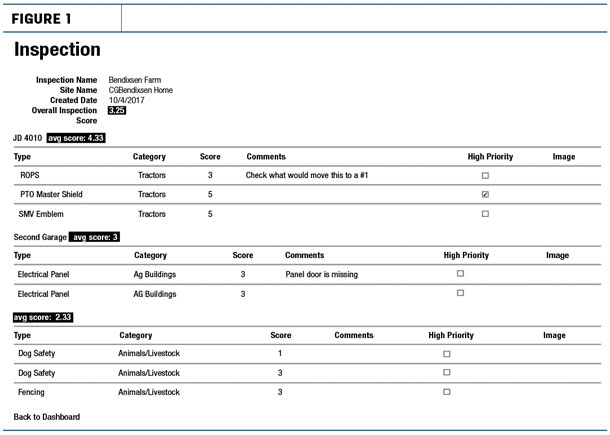Issue 16 of Progressive Dairyman (Oct. 10, 2017) highlighted the Rural Firefighters Delivering Agricultural Safety and Health (RFDASH) project from the National Farm Medicine Center.
This project encourages rural emergency responders to work with farmers and farm managers to help prevent farm injuries and fatalities by engaging in a four-part curriculum.
In Issue 17, we highlighted the program’s features meant to help protect first responders during farm emergencies and expedite their response, Use Farm MAPPER to assist, protect, prepare emergency responders specifically through pre-planning and using tools like FarmMapper.
The module highlighted here is about preventing the need for emergency medical services (EMS) in the first place – by identifying and mitigating farm hazards.
This is at the heart of our project’s purpose, encouraging rural fire and EMS professionals to assist farm and ranch owners and managers to identify and mitigate hazards on the operation before fire or medical emergencies arise.
As opposed to insurance companies or regulatory agencies, trained local fire and EMS departments can offer an unbiased, inexpensive, third-party option to safety inspection activities. Moreover, these efforts come from a sincere sense of community well-being. Our research has shown most farmers will trust their local fire and EMS professionals about changes to improve safety on their operation.
Farm hazard analysis and mitigation can be an entire career for some people, mastering aspects of engineering, hygiene, safety and public health. While many rural fire departments likely have people familiar with agriculture, that’s becoming less common.
Therefore, many rural fire and EMS could use some familiarization with farming and farm hazard identification. And while many emergency responders already have some training in risk and hazard analysis as a part of their response training, the trick is leveraging those skills toward unique farm hazards. The most important elements of safety inspection include tractors (especially rollover protective structures and power take-offs), implements, confined spaces and hazards related to drowning/engulfment and fire.
Web-based tool
In order to assist those less familiar with agriculture and its hazards, our project utilizes another free web-based tool (Safer Farm). This online tool enables farmers, firefighters and others to accurately identify and score common farm hazards.
SaferFarm.org is an evolution from a tried-and-true method of farm hazard inspection developed at Penn State University Extension. It provides a simple method for providing firsthand information about and a process for evaluating potential hazards, and recommendations on correcting hazards in agricultural environments.
In demonstration studies, excellent consistencies in scoring results were achieved across distinctly different groups of users. The core of this process has been developed into a mobile-friendly, online format at SaferFarm.org. Features such as geo-locating and capturing photographs have also been added.
SaferFarm.org walks an auditor and farm manager through hundreds of typical farm hazards, identifying and scoring each potential hazard. From this, a detailed inspection report helps establish priorities to be addressed (Figure 1).
 SaferFarm.org allows users to select categories and topics at their leisure to conduct hazard audits in a timely and organized fashion, and in a non-threatening environment. It guides users toward a reduction in number and degree of hazards and risk and facilitates an easy-to-use standardized auditing process that adds objectivity to hazard evaluations.
SaferFarm.org allows users to select categories and topics at their leisure to conduct hazard audits in a timely and organized fashion, and in a non-threatening environment. It guides users toward a reduction in number and degree of hazards and risk and facilitates an easy-to-use standardized auditing process that adds objectivity to hazard evaluations.
It also serves as a training tool for educators working with youth and other groups, teaching how to conduct hazard audits, and provides an objective method for evaluating risks and hazards at diverse farming operations. Published research shows targeted hazard inspections lead to greater hazard and risk reduction than more general approaches to farm safety.
This platform is now available but in development form. Further refinement is currently underway at the National Farm Medicine Center with the technical expertise of the Biomedical Informatics Research Center within the Marshfield Clinic Research Institute.
We encourage farmers and fire departments to visit www.SaferFarm.org and learn more about farm hazard analysis. If you are involved in your fire department, inquire about being trained in the RFDASH curriculum by e-mailing Casper Bendixsen. ![]()
Kate Barnes, MS, MPH is a research specialist at the National Farm Medicine Center.
This project is supported by a grant from the Centers for Disease Control and Prevention-National Institute for Occupational Safety and Health (CDC-NIOSH), in collaboration with the Upper Midwest Agricultural Safety and Health Center.

-
Casper ‘Cap’ Bendixsen
- Associate Research Scientist/Cultural Anthropologist
- National Farm Medicine Center
- Email Casper ‘Cap’ Bendixsen







